Temperature-Dependent Resistive Properties of Vanadium Pentoxide/Vanadium Multi-Layer Thin Films for Microbolometer & Antenna-Coupled Microbolometer Applications
Abstract
:1. Introduction
2. Materials and Methods
3. Results
4. Discussion
5. Conclusions
Author Contributions
Funding
Conflicts of Interest
References
- Kruse, P.W. Uncooled Thermal Imaging Arrays, Systems, and Applications; SPIE: Washington, DC, USA, 2002. [Google Scholar]
- Niklaus, F.; Vieider, C.; Jakobsen, H. MEMS-based uncooled infrared bolometer arrays: A review. In Proceedings of the SPIE on MEMS, MOEMS Technologies and Applications III, Beijing, China, 11–15 November 2007; SPIE: Washington, DC, USA, 2008. [Google Scholar]
- Dem’yanenko, M.A.; Esaev, D.G.; Ovsyuk, V.N.; Fomin, B.I.; Aseev, A.L.; Knyazev, B.A.; Kulipanov, G.N.; Vinokurov, N.A. Microbolometer detector arrays for the infrared and terahertz ranges. J. Opt. Technol. 2009, 76, 739–743. [Google Scholar] [CrossRef]
- Wood, R.A. Monolithic Silicon Microbolometer Arrays. In Semiconductors and Semimetals; Kruse, P.W., Skatrud, D.D., Eds.; Elsevier: Amsterdam, The Netherlands, 1997. [Google Scholar]
- Mubarak, M.H.; Sidek, O.; Abdel-Rahman, M.R.; Mustaffa, M.T.; Mustapa Kamal, A.S.; Mukras, S.M. Nano-Antenna Coupled Infrared Detector Design. Sensors 2018, 18, 3714. [Google Scholar] [CrossRef] [PubMed]
- Gonzalez, F.; Ilic, B.; Alda, J.; Boreman, G. Antenna-coupled infrared detectors for imaging applications. IEEE J. Sel. Top. Q. 2005, 11, 117–120. [Google Scholar] [CrossRef]
- Middlebrook, C.T.; Krenz, P.M.; Lail, B.A.; Boreman, G.D. Infrared phased-array antenna. Microw. Opt. Technol. Lett. 2008, 50, 719–723. [Google Scholar] [CrossRef]
- Krenz, P.; Alda, J.; Boreman, G.D. Orthogonal infrared dipole antenna. Infrared Phys. Technol. 2008, 51, 340–343. [Google Scholar] [CrossRef]
- González, F.J.; Boreman, G.D. Comparison of dipole, bowtie, spiral and log-periodic IR antennas. Infrared Phys. Technol. 2005, 46, 418–428. [Google Scholar] [CrossRef]
- Gonzalez, F.J.; Abdel-Rahman, M.A.; Boreman, G.D. Antenna-coupled VOx thin film microbolometer array. Microw. Opt. Technol. Lett. 2003, 38, 235–237. [Google Scholar] [CrossRef]
- Miller, A.J.; Luukanen, A.; Grossman, E.N. Micromachined antenna-coupled uncooled bolometers for terahertz imaging. In Proceedings of the SPIE 5411, Terahertz for Military and Security Applications II, Orlando, FL, USA, 12–16 April 2004; SPIE: Washington, DC, USA, 2004. [Google Scholar]
- Nolen, S.; Koch, J.A.; Paulter, N.G.; Reintsema, C.D.; Grossman, E.N. Antenna-coupled niobium bolometers for mm-wave imaging arrays. In Proceedings of the SPIE Conference on Terahertz and Gigahertz Photonics, Denver, CO, USA, 18–23 July 1999; SPIE: Washington, DC, USA, 1999. [Google Scholar]
- Abdel-Rahman, M.; Ilahi, S.; Zia, M.F.; Alduraibi, M.; Debbar, N.; Yacoubi, N.; Ilahi, B. Temperature coefficient of resistance and thermal conductivity of vanadium oxide ‘Big Mac’ sandwich structure. Infrared Phys. Technol. 2015, 71, 127–130. [Google Scholar] [CrossRef]
- Zia, M.; Abdel-Rahman, M.; Alduraibi, M.; Ilahi, B.; Alasaad, A. Synthesis and electrical characterization of vanadium oxide thin film thermometer for microbolometer applications. Electron. Lett. 2016, 52, 827–828. [Google Scholar] [CrossRef]
- Ilahi, B.; Abdel-Rahman, M.; Zaaboub, Z.; Zia, M.; Alduraibi, M.; Maaref, H. Thermal annealing induced multiple phase in V/V2O5 alternating multilayer structure. Int. J. Mod. Phys. B 2016, 30, 1650210. [Google Scholar] [CrossRef]
- Zia, M.; Abdel-Rahman, M.; Alduraibi, M.; Ilahi, B.; Awad, E.; Majzoub, S. Electrical and infrared optical properties of vanadium oxide semiconducting thin film thermometers. J. Electron. Mater. 2017, 46, 5978–5985. [Google Scholar] [CrossRef]
- Abdel-Rahman, M. Vanadium Oxide Thin Films with High Midwave & Longwave Infrared Thermo-Optic Coefficients and High Temperature Coefficients of Resistance. Optik 2018, 159, 79–86. [Google Scholar]
- Abdel-Rahman, M.; Alduraibi, M.; Zia, M.; Bahidra, E.; Alasaad, A. Vanadium sesquioxide (V2O3)-based semiconducting temperature sensitive resistors for uncooled microbolometers. Mod. Phys. Lett. B 2017, 31, 1750145. [Google Scholar] [CrossRef]
- Généreux, F.; Provençal, B.; Tremblay, M.; Boucher Julien, C.; Alain, C. Vanadium oxide thin film with improved sheet resistance uniformity. In Proceedings of the SPIE on Infrared Technology and Applications XL, Baltimore, MD, USA, 5–9 May 2014; SPIE: Washington, DC, USA, 2014. [Google Scholar]
- Benirschke, D.; Howard, S. Characterization of a low-cost, commercially available, vanadium oxide microbolometer array for spectroscopic imaging. Opt. Eng. 2017, 56, 040502. [Google Scholar] [CrossRef]
- Fisette, B.; Tremblay, M.; Oulachgar, H.; Généreux, F.; Béland, D.; Beaupré, P.; Julien, C.; Gay, D.; Deshaies, S.; Terroux, M.; et al. Novel vacuum packaged 384 × 288 broadband bolometer FPA with enhanced absorption in the 3–14 µm wavelength range. In Proceedings of the SPIE 10177, Infrared Technology and Applications XLIII, Anaheim, CA, USA, 9–13 April 2017; SPIE: Washington, DC, USA, 2017. [Google Scholar]
- Frame, J.D.; Green, N.G.; Kubo, W.; Fang, X. Plasmonic vanadium dioxide microbolometers with wavelength and polarisation sensitivity. In Proceedings of the SPIE 10722, Plasmonics: Design, Materials, Fabrication, Characterization, and Applications XVI, San Diego, CA, USA, 19–23 August 2018; SPIE: Washington, DC, USA, 2018. [Google Scholar]
- Ajmera, S.K.; Syllaios, A.J.; Tyber, G.S.; Taylor, M.F.; Hollingsworth, R.E. Amorphous silicon thin-films for uncooled infrared microbolometer sensors. In Proceedings of the SPIE 7660 on Infrared Technology and Applications XXXVI, Anaheim, CA, USA, 5–9 April 2010; SPIE: Washington, DC, USA, 2010. [Google Scholar]
- Tissot, J.-L.; Mottin, E.; Martin, J.-L.; Yon, J.-J.; Vilain, M. Advanced uncooled infrared focal plane development at CEA/LETI. In Proceedings of the SPIE 10569, International Conference on Space Optics—ICSO 2000, Toulouse Labège, France, 5–7 December 2000; SPIE: Washington, DC, USA, 2017. [Google Scholar]
- Shin, C.; Pham, D.P.; Park, J.; Kim, S.; Lee, Y.-J.; Yi, J. Structure and electrical properties of boron doped hydrogenated mixed-phase silicon films for uncooled microbolometer. Infrared Phys. Technol. 2019, 96, 84–88. [Google Scholar] [CrossRef]
- Voshell, A.; Dhar, N.; Rana, M.M. Materials for microbolometers: Vanadium oxide or silicon derivatives. In Proceedings of the SPIE 10209, Image Sensing Technologies: Materials, Devices, Systems, and Applications IV, Anaheim, CA, USA, 9–13 April 2017; SPIE: Washington, DC, USA, 2017. [Google Scholar]
- Tilkioglu, B.T.; Bolat, S.; Tanrikulu, M.Y.; Okyay, A.K. Digitally alloyed ZnO and TiO2 thin film thermistors by atomic layer deposition for uncooled microbolometer applications. J. Vac. Sci. Technol. A 2017, 35, 021513. [Google Scholar] [CrossRef]
- Jagtap, V.S.; Dégardin, A.F.; Kreisler, A.J. Low temperature amorphous growth of semiconducting Y-Ba-Cu-O oxide thin films in view of infrared bolometric detection. Thin Solid Films 2012, 520, 4754–4757. [Google Scholar] [CrossRef]
- Jeong, Y.J.; Kang, S.G.; Kwon, M.H.; Jung, H. Development of titanium oxide based 12 µm pixel pitch uncooled infrared detector. In Proceedings of the SPIE 10624, Infrared Technology and Applications XLIV, Orlando, FL, USA, 15–19 April 2018; SPIE: Washington, DC, USA, 2018. [Google Scholar]
- Wu, Z.-Y.; Tang, S.-F.; Zeng, H.-Y.; Lin, W.-J.; Chen, T.-C.; Gau, Y.-T. Infrared response of vanadium oxide (VOx)/SiNx/reduced graphene oxide (rGO) composite microbolometer. Microelectron. Reliab. 2018, 91, 313–318. [Google Scholar] [CrossRef]
- Basantani, H.A. Effect of RF Substrate Bias on Vanadium Oxide Thin Films during Reactive Pulsed DC Magnetron Sputter Deposition. Master’s Thesis, Pennsylvania State University, State College, PA, USA, 2011. [Google Scholar]
- Jin, Y. Reactive Sputter Deposition of Vanadium, Nickel, and Molybdenum Oxide Thin Films for Use in Uncooled Infrared Imaging. Ph.D. Thesis, Pennsylvania State University, State College, PA, USA, 2014. [Google Scholar]
- Abdel-Rahman, M.; Al-Khalli, N.; Zia, M.F.; Alduraibi, M.; Ilahi, B.; Awad, E.; Debbar, N. Fabrication and design of vanadium oxide microbolometer. In Proceedings of the 6th International Advances in Applied Physics and Materials Science Congress & Exhibition, Istanbul, Turkey, 1–3 June 2016; AIP: Washington, DC, USA, 2017. [Google Scholar]
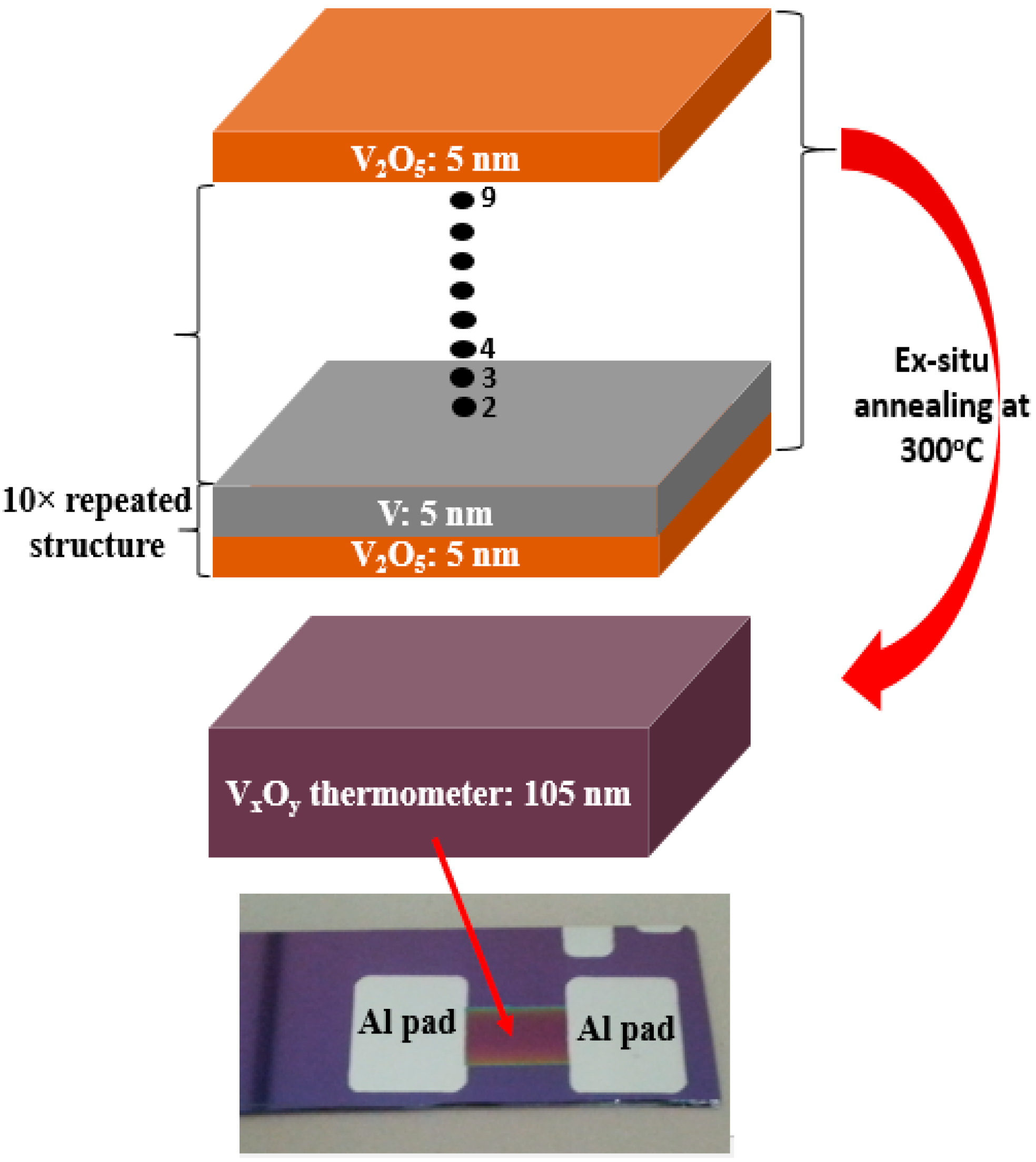
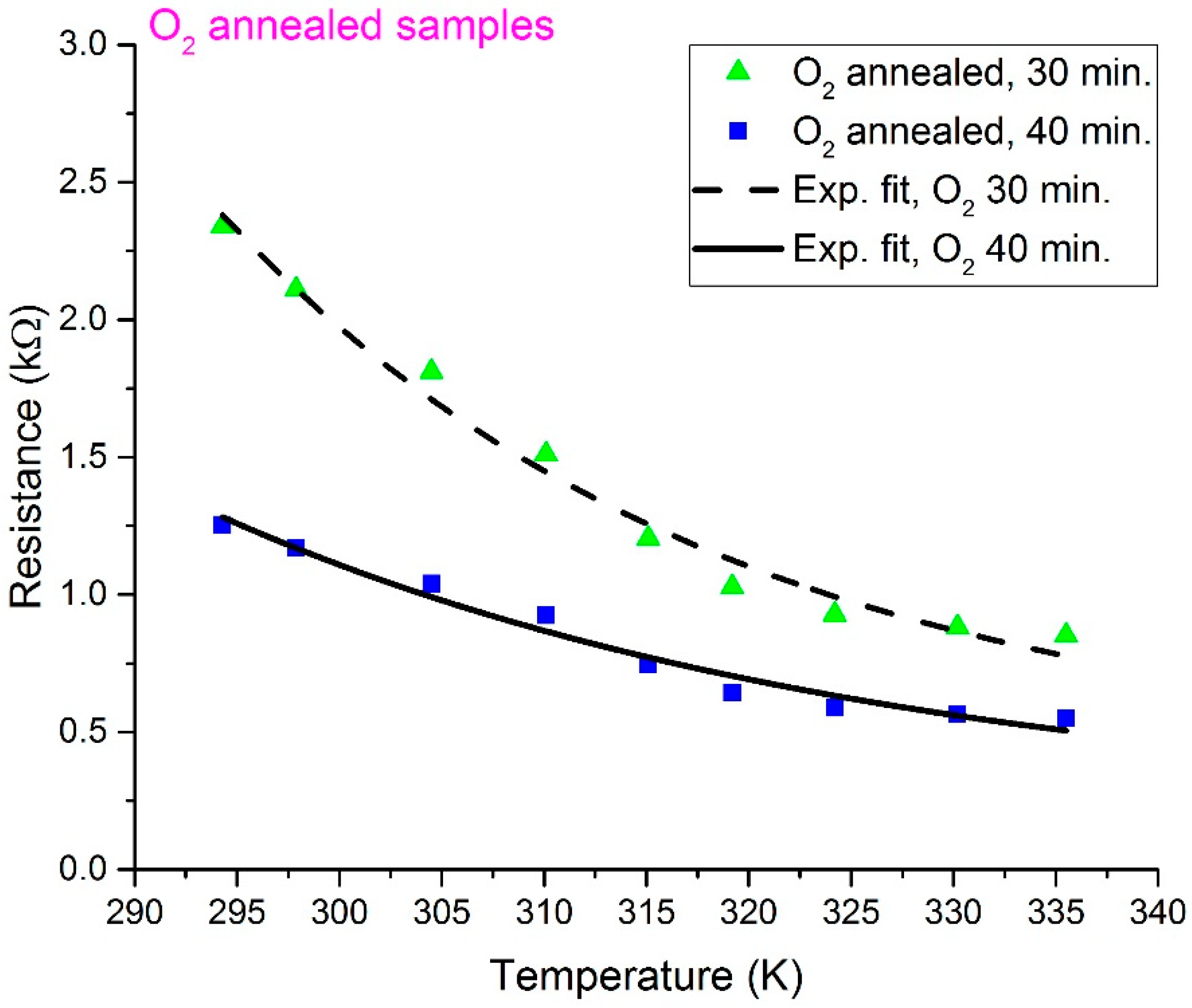
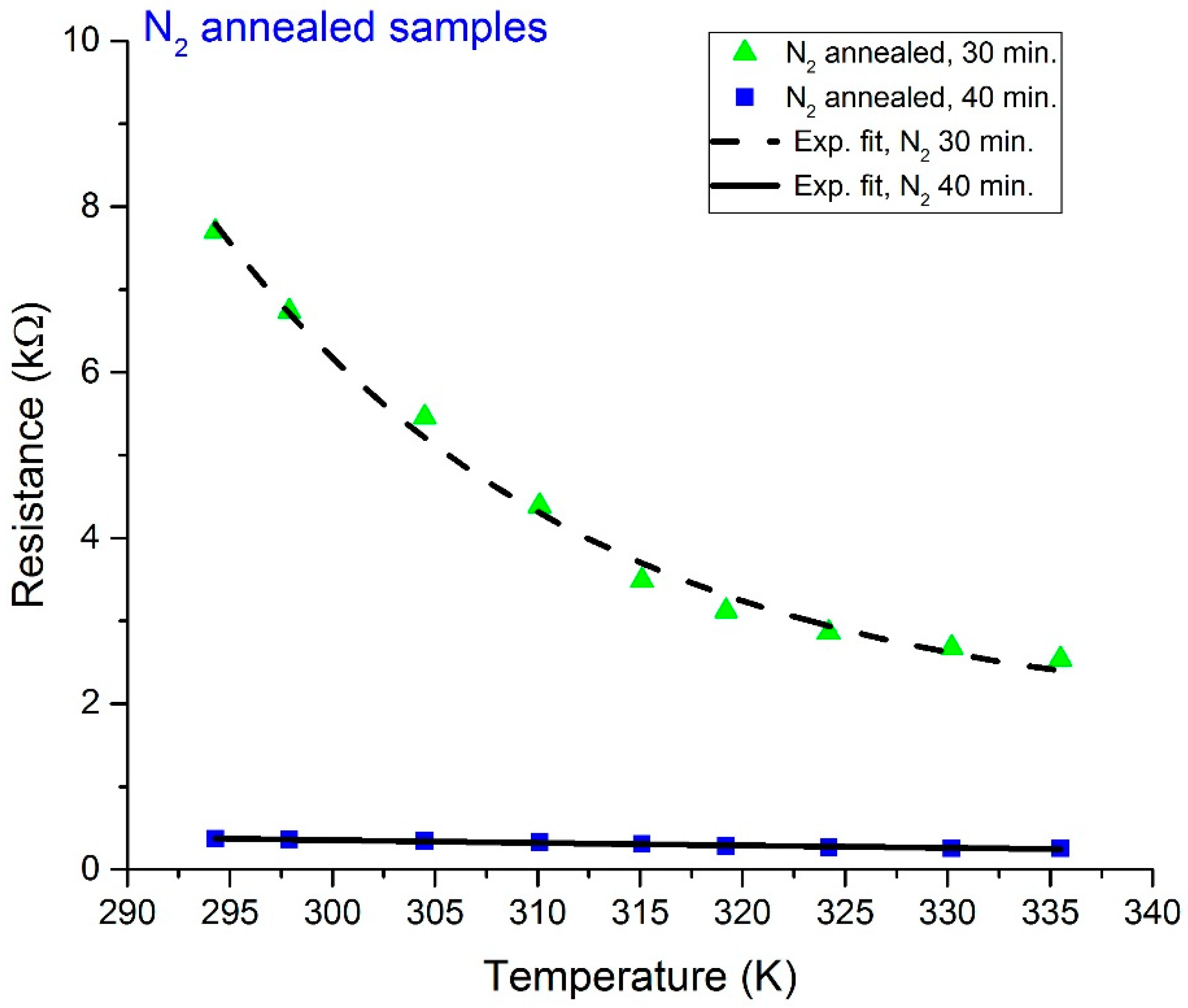

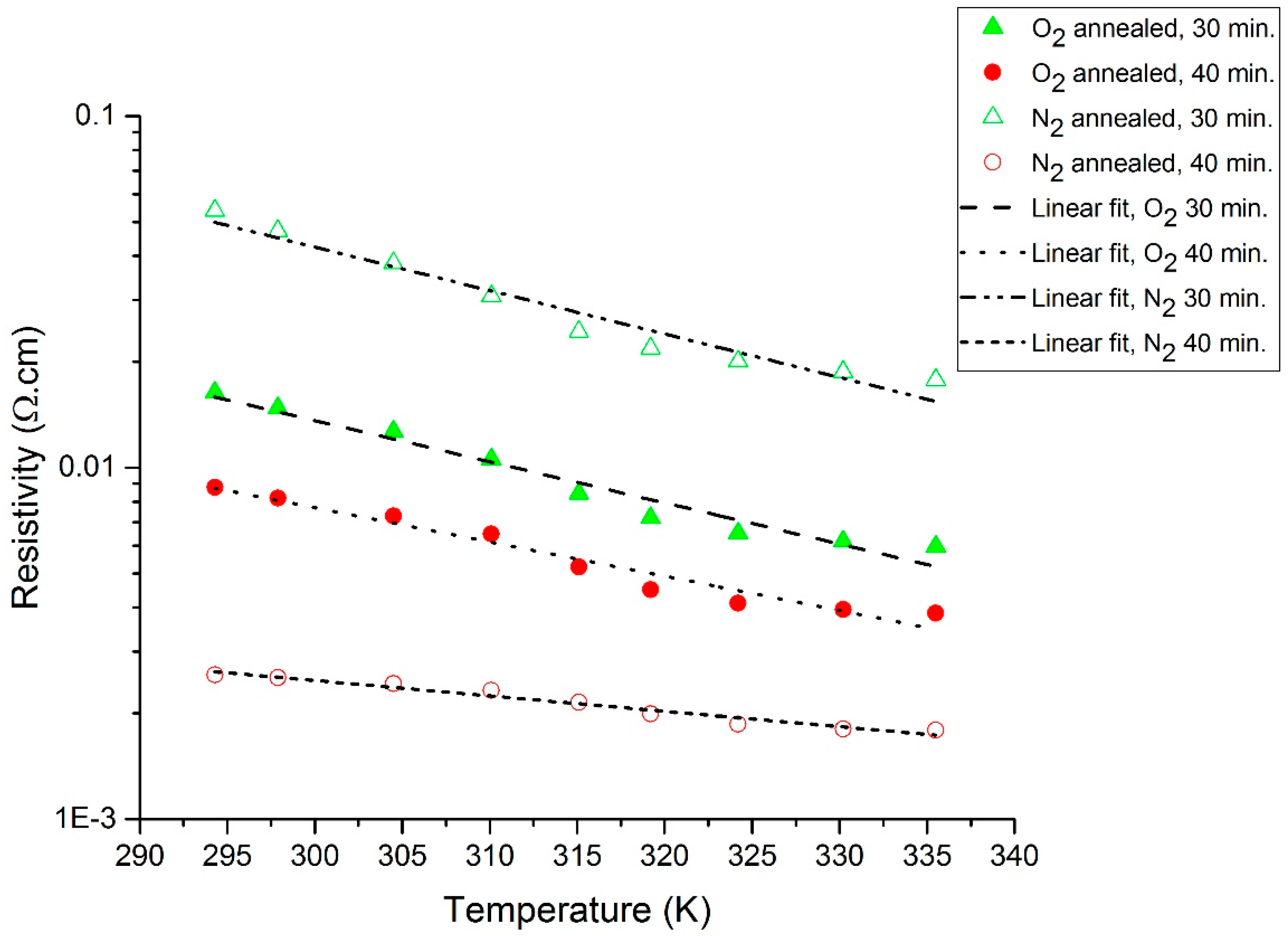
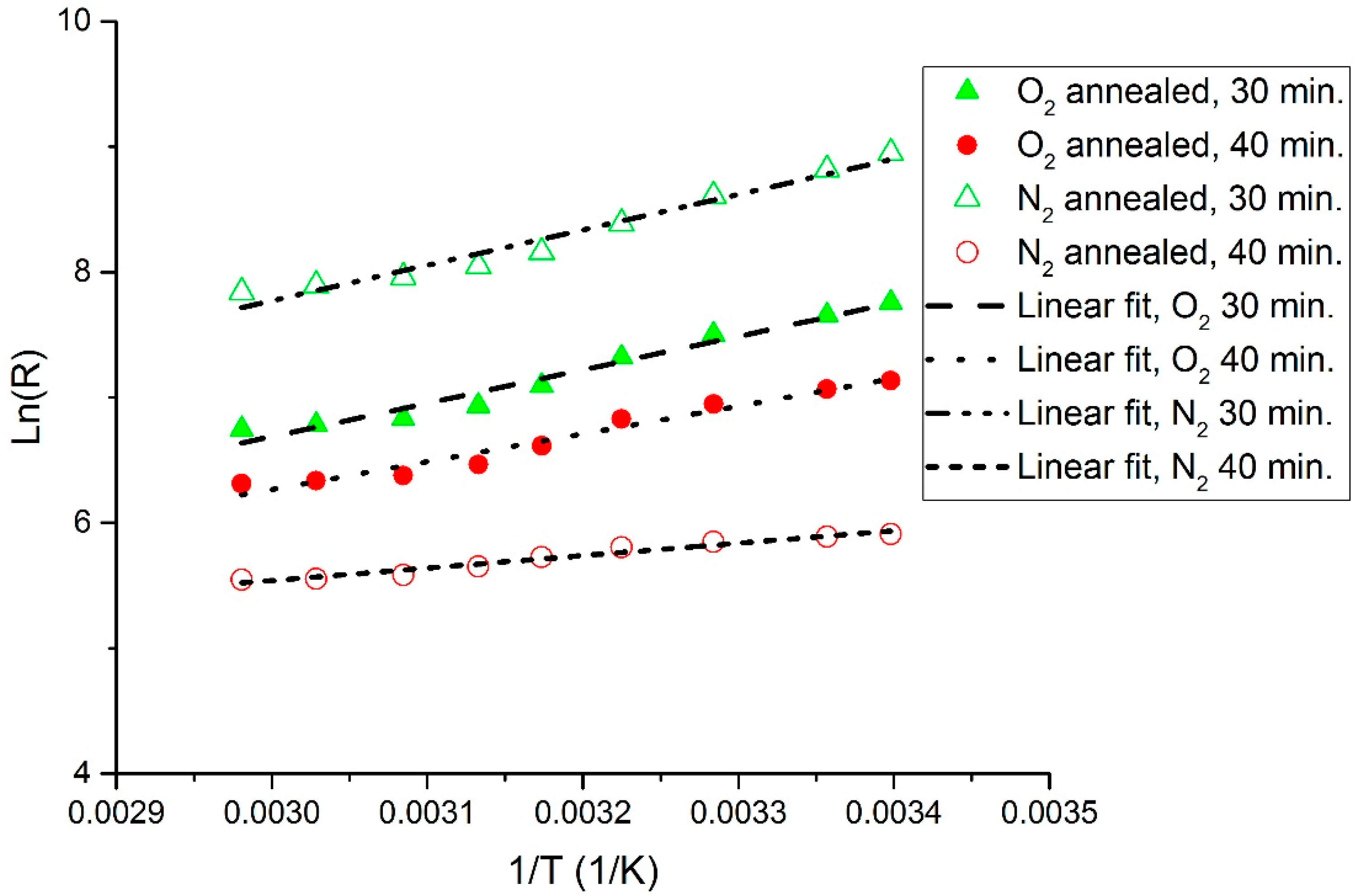
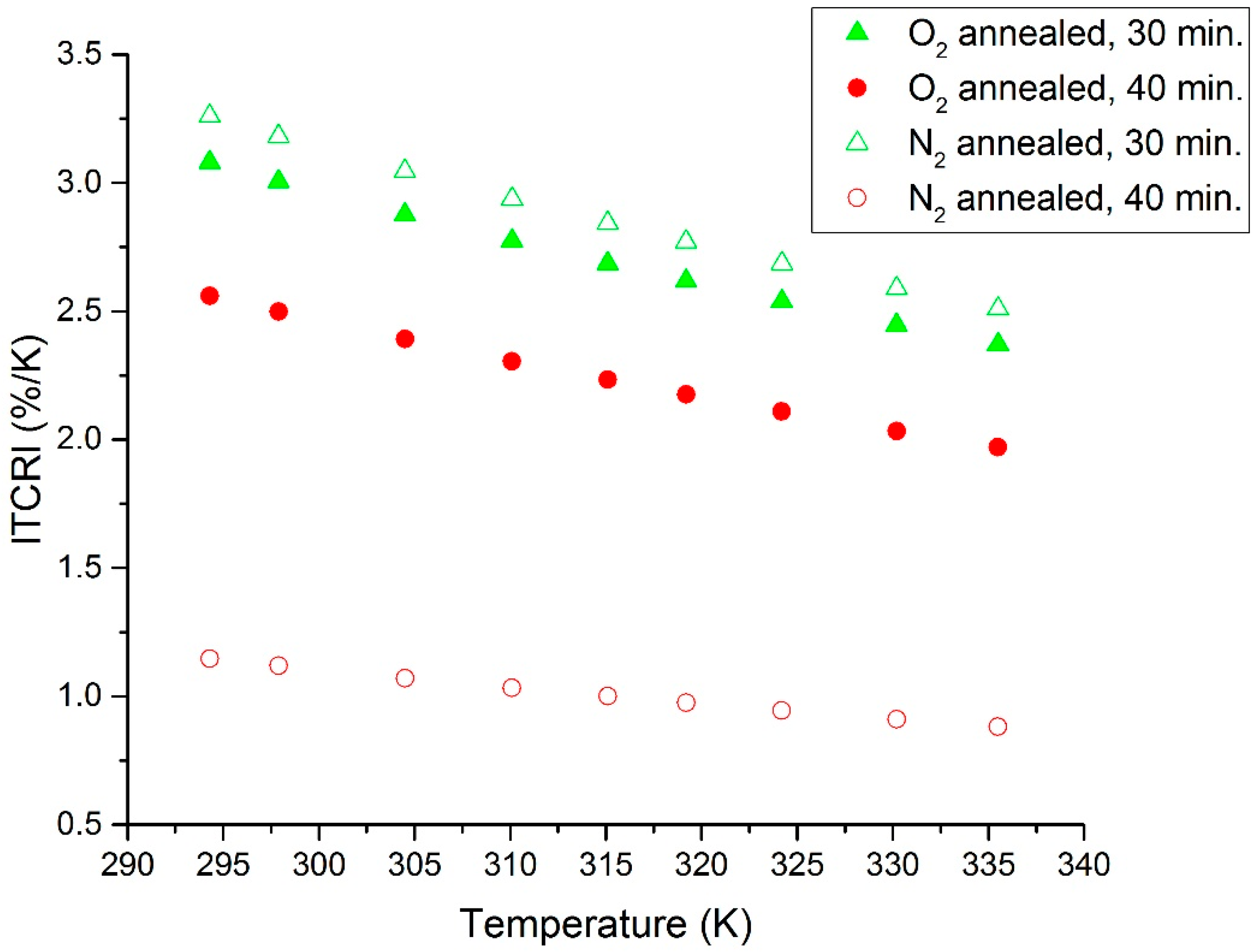
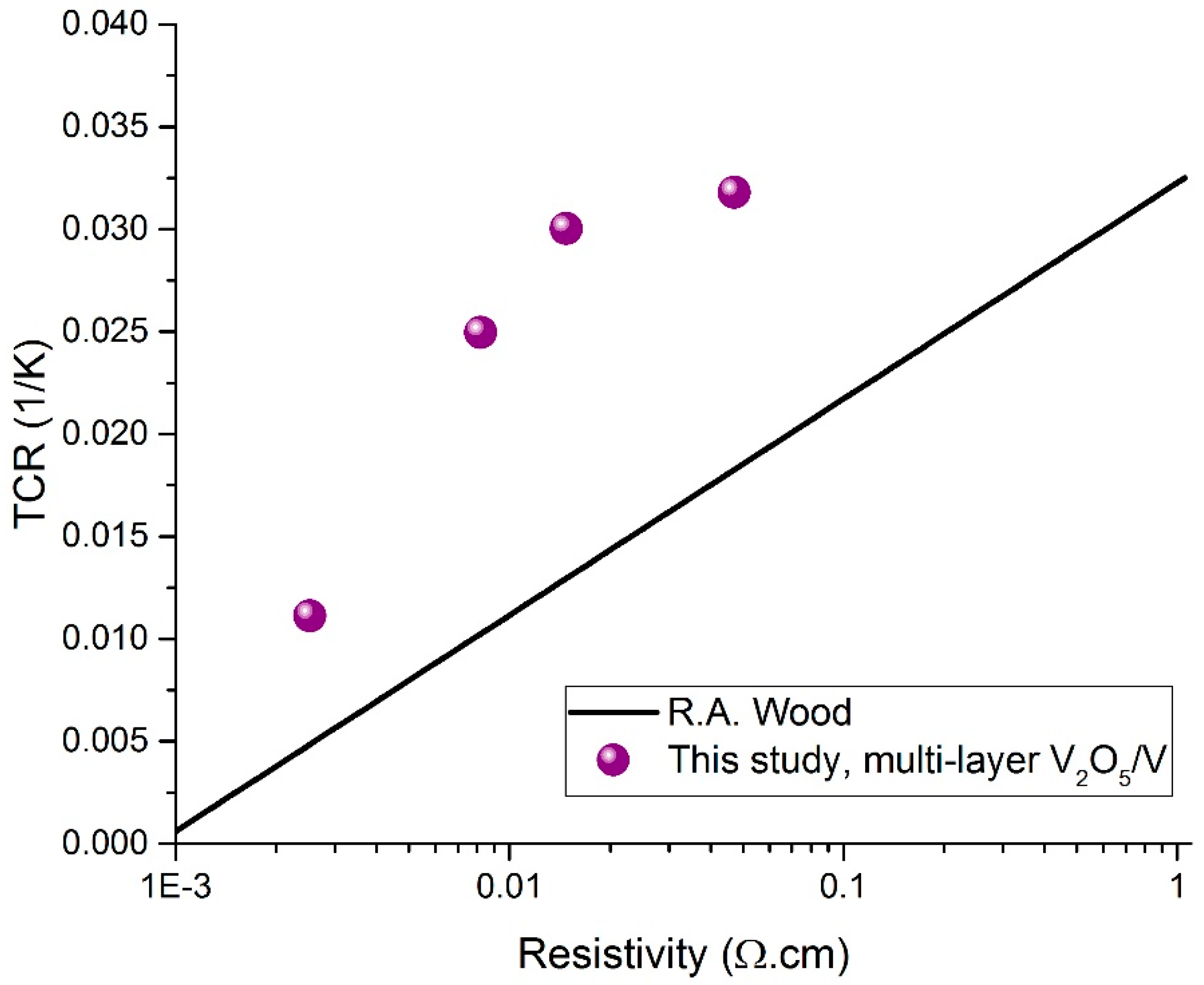
| Sample ID | Resistance (kΩ) at R.T. | Resistivity (Ω·cm) at R.T. | TCR (%/K) | ΔE (eV) | Ro (Ω) |
|---|---|---|---|---|---|
| O2_30min.anneal | 2.11 | 0.01477 | −3.0036 | 0.229 | 0.162 |
| O2_40min.anneal | 1.17 | 0.00819 | −2.4964 | 0.191 | 41.797 |
| N2_30min.anneal | 6.74 | 0.04718 | −3.18 | 0.243 | 0.517 |
| N2_40min.anneal | 0.361 | 0.002527 | −1.1181 | 0.085 | 12.896 |
© 2019 by the authors. Licensee MDPI, Basel, Switzerland. This article is an open access article distributed under the terms and conditions of the Creative Commons Attribution (CC BY) license (http://creativecommons.org/licenses/by/4.0/).
Share and Cite
Abdel-Rahman, M.; Zia, M.; Alduraibi, M. Temperature-Dependent Resistive Properties of Vanadium Pentoxide/Vanadium Multi-Layer Thin Films for Microbolometer & Antenna-Coupled Microbolometer Applications. Sensors 2019, 19, 1320. https://doi.org/10.3390/s19061320
Abdel-Rahman M, Zia M, Alduraibi M. Temperature-Dependent Resistive Properties of Vanadium Pentoxide/Vanadium Multi-Layer Thin Films for Microbolometer & Antenna-Coupled Microbolometer Applications. Sensors. 2019; 19(6):1320. https://doi.org/10.3390/s19061320
Chicago/Turabian StyleAbdel-Rahman, Mohamed, Muhammad Zia, and Mohammad Alduraibi. 2019. "Temperature-Dependent Resistive Properties of Vanadium Pentoxide/Vanadium Multi-Layer Thin Films for Microbolometer & Antenna-Coupled Microbolometer Applications" Sensors 19, no. 6: 1320. https://doi.org/10.3390/s19061320





